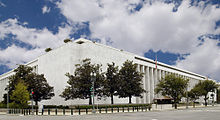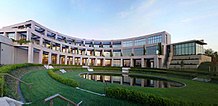Library of Congress
  | |
 Flag of the Library of Congress | |
| Established | April 24, 1800 |
|---|---|
| Location | Washington, D.C., U.S. |
| Coordinates | 38°53′19″N 77°00′17″W / 38.88861°N 77.00472°WCoordinates: 38°53′19″N 77°00′17″W / 38.88861°N 77.00472°W |
| Branches | N/A |
| Collection | |
| Size | More than 38 million books and other printed materials, 3.6 million recordings, 14 million photographs, 5.5 million maps, 8.1 million pieces of sheet music and 70 million manuscripts, 5,711 incunabula, and 122,810,430 items in the nonclassified (special) collections: more than 167,000,000 total items[1] |
| Access and use | |
| Circulation | Library does not publicly circulate |
| Population served | 535 members of the United States Congress, their staff, and members of the public |
| Other information | |
| Budget | $684,040,000[2] |
| Director | Carla Hayden (Librarian of Congress) |
| Staff | 3,105[2] |
| Website | LoC.gov |
The Library of Congress (LOC) is the research library that officially serves the United States Congress and is the de facto national library of the United States. It is the oldest federal cultural institution in the United States. The Library is housed in three buildings on Capitol Hill in Washington, D.C.; it also maintains the National Audio-Visual Conservation Center in Culpeper, Virginia.[1] The Library's functions are overseen by the Librarian of Congress, and its buildings are maintained by the Architect of the Capitol. The Library of Congress has claims to be the largest library in the world.[3][4] Its "collections are universal, not limited by subject, format, or national boundary, and include research materials from all parts of the world and in more than 450 languages."[1]
The Library of Congress moved to Washington in 1800 after sitting for 11 years in the temporary national capitals in New York City and Philadelphia. The small Congressional Library was housed in the United States Capitol for most of the 19th century until the early 1890s. Most of the original collection had been destroyed by the British in 1814 during the War of 1812, and the library sought to restore its collection in 1815. They bought Thomas Jefferson's entire personal collection of 6,487 books. After a period of slow growth, another fire struck the Library in its Capitol chambers in 1851, again destroying a large amount of the collection, including many of Jefferson's books. After the American Civil War, the Library of Congress grew rapidly in both size and importance, which sparked a campaign to purchase replacement copies for volumes that had been burned. The Library received the right of transference of all copyrighted works to deposit two copies of books, maps, illustrations, and diagrams printed in the United States. It also began to build its collections, and its development culminated between 1888 and 1894 with the construction of a separate, extensive library building across the street from the Capitol.
The Library's primary mission is to research inquiries made by members of Congress, carried out through the Congressional Research Service. The Library is open to the public, although only high-ranking government officials and Library employees may check out books and materials.
Contents
History[edit]
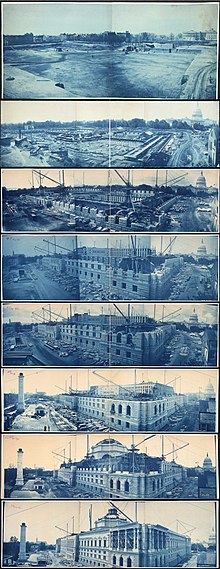
1800–1851: Origin and Jefferson's contribution[edit]
James Madison is credited with the idea of creating a congressional library, first making such a proposition in 1783.[5] The Library of Congress was subsequently established April 24, 1800 when President John Adams signed an act of Congress providing for the transfer of the seat of government from Philadelphia to the new capital city of Washington. Part of the legislation appropriated $5,000 "for the purchase of such books as may be necessary for the use of Congress ... and for fitting up a suitable apartment for containing them."[6] Books were ordered from London, and the collection consisted of 740 books and three maps which were housed in the new United States Capitol.[7]
President Thomas Jefferson played an important role in establishing the structure of the Library of Congress. On January 26, 1802, he signed a bill that allowed the president to appoint the Librarian of Congress and establishing a Joint Committee on the Library to regulate and oversee it. The new law also extended borrowing privileges to the President and Vice President.[8][9]
The invading British army burned Washington in August 1814 during the War of 1812 and destroyed the Library of Congress and its collection of 3,000 volumes.[7] These volumes had been left in the Senate wing of the Capitol.[9] One of the few congressional volumes to survive was a government account book of receipts and expenditures for 1810.[10] It was taken as a souvenir by British Admiral George Cockburn, whose family returned it to the United States government in 1940.[11]
Within a month, Thomas Jefferson offered to sell his personal library[12][13] as a replacement. Congress accepted his offer in January 1815, appropriating $23,950 to purchase his 6,487 books.[7] Some members of the House of Representatives opposed the outright purchase, including New Hampshire Representative Daniel Webster who wanted to return "all books of an atheistical, irreligious, and immoral tendency."[14] Jefferson had spent 50 years accumulating a wide variety of books in several languages and on subjects such as philosophy, history, law, religion, architecture, travel, natural sciences, mathematics, studies of classical Greece and Rome, modern inventions, hot air balloons, music, submarines, fossils, agriculture, and meteorology.[5] He had also collected books on topics not normally viewed as part of a legislative library, such as cookbooks. However, he believed that all subjects had a place in the Library of Congress. He remarked:
I do not know that it contains any branch of science which Congress would wish to exclude from their collection; there is, in fact, no subject to which a Member of Congress may not have occasion to refer.[14]
Jefferson's collection was unique in that it was the working collection of a scholar, not a gentleman's collection for display. His original collection was organized into a scheme based on Francis Bacon's organization of knowledge. Specifically, he grouped his books into Memory, Reason, and Imagination, which broke down into 44 more subdivisions. The Library followed Jefferson's organization scheme until the late 19th century, when librarian Herbert Putnam began work on a more flexible Library of Congress Classification structure that now applies to more than 138 million items.
In 1851, a fire destroyed two thirds of the Jefferson collection, with only 2,000 books remaining. By 2008, the Librarians of Congress had found replacements for all but 300 of the works that were in Jefferson's original collection.[15]
1851–1865: Weakening[edit]
On December 22, 1851 the largest fire in the Library's history destroyed 35,000 books, about two–thirds of the Library's collection and two-thirds of Jefferson's original transfer.[16] Congress appropriated $168,700 to replace the lost books in 1852 but not to acquire new materials.[17] This marked the start of a conservative period in the Library's administration by librarian John Silva Meehan and joint committee chairman James A. Pearce, who restricted the Library's activities.[17] Meehan and Pearce's views about a restricted scope for the Library of Congress reflected those shared by members of Congress. While Meehan was Librarian he supported and perpetuated the notion that "the congressional library should play a limited role on the national scene and that its collections, by and large, should emphasize American materials of obvious use to the U.S. Congress."[18] In 1859, Congress transferred the Library's public document distribution activities to the Department of the Interior and its international book exchange program to the Department of State.[19]
During the 1850s, Smithsonian Institution librarian Charles Coffin Jewett aggressively tried to make the Smithsonian into the United States' national library. His efforts were blocked by Smithsonian secretary Joseph Henry, who advocated a focus on scientific research and publication.[20] To reinforce his intentions for the Smithsonian, Henry established laboratories, developed a robust physical sciences library and started the Smithsonian Contributions to Knowledge, the first of many publications intended to disseminate research results.[21] For Henry, the Library of Congress was the obvious choice as the national library. Unable to resolve the conflict, Henry dismissed Jewett in July 1854. In 1865 the Smithsonian building, also called the Castle due to its Norman architectural style, was devastated by fire and presented Henry an opportunity in regards to the Smithsonian's non-scientific library. Around this time, the Library of Congress was making plans to build and relocate to the new Thomas Jefferson Building, which would be fire proof.[22] Authorized by an act of Congress, he transferred the Smithsonian's non-scientific library of 40,000 volumes to the Library of Congress in 1866.[23]
Abraham Lincoln appointed John G. Stephenson as Librarian of Congress in 1861 and the appointment is regarded as the most political to date.[24] Stephenson was a physician and spent equal time serving as Librarian and as a physician in the Union Army. He could manage this division of interest because he hired Ainsworth Rand Spofford as his assistant.[24] Despite his new job, Stephenson's focus was on non-library affairs; three weeks into his term, he left Washington, D.C. to serve as a volunteer aide-de-camp at the battles of Chancellorsville and Gettysburg during the American Civil War.[24] Stephenson's term as Librarian seems to have left little imprint on the Library although hiring Spofford, who was left to run the Library in his absence, may have been his most significant achievement.[24]
1865–1897: Spofford's expansion[edit]
The Library of Congress reasserted itself during the latter half of the 19th century under Librarian Ainsworth Rand Spofford who directed it from 1865 to 1897. He built broad bipartisan support for it as a national library and a legislative resource, aided by an overall expansion of the federal government and a favorable political climate. He began comprehensively collecting Americana and American literature, led the construction of a new building to house the Library, and transformed the Librarian of Congress position into one of strength and independence. Between 1865 and 1870, Congress appropriated funds for the construction of the Thomas Jefferson Building, placed all copyright registration and deposit activities under the Library's control, and restored the international book exchange. The Library also acquired the vast libraries of the Smithsonian and of historian Peter Force, strengthening its scientific and Americana collections significantly. By 1876, the Library of Congress had 300,000 volumes and was tied with the Boston Public Library as the nation's largest library. It moved from the Capitol building to its new headquarters in 1897 with more than 840,000 volumes, 40 percent of which had been acquired through copyright deposit.[7]
A year before the Library's move to its new location, the Joint Library Committee held a session of hearings to assess the condition of the Library and plan for its future growth and possible reorganization. Spofford and six experts sent by the American Library Association[25] testified that the Library should continue its expansion towards becoming a true national library. Congress more than doubled the Library's staff from 42 to 108 based on the hearings, and with the assistance of Senators Justin Morrill of Vermont and Daniel W. Voorhees of Indiana, and established new administrative units for all aspects of the collection. Congress also strengthened the office of Librarian of Congress to govern the Library and make staff appointments, as well as requiring Senate approval for presidential appointees to the position.[7]
1897–1939: Post-reorganization[edit]

The Library of Congress, spurred by the 1897 reorganization, began to grow and develop more rapidly. Spofford's successor John Russell Young, though only in office for two years, overhauled the Library's bureaucracy, used his connections as a former diplomat to acquire more materials from around the world, and established the Library's first assistance programs for the blind and physically disabled. Young's successor Herbert Putnam held the office for forty years from 1899 to 1939, entering into the position two years before the Library became the first in the United States to hold one million volumes.[7] Putnam focused his efforts on making the Library more accessible and useful for the public and for other libraries. He instituted the interlibrary loan service, transforming the Library of Congress into what he referred to as a "library of last resort".[26] Putnam also expanded Library access to "scientific investigators and duly qualified individuals" and began publishing primary sources for the benefit of scholars.[7]
Putnam's tenure also saw increasing diversity in the Library's acquisitions. In 1903, he persuaded President Theodore Roosevelt to transfer by executive order the papers of the Founding Fathers from the State Department to the Library of Congress. Putnam expanded foreign acquisitions as well, including the 1904 purchase of a four-thousand volume library of Indica, the 1906 purchase of G. V. Yudin's eighty-thousand volume Russian library, the 1908 Schatz collection of early opera librettos, and the early 1930s purchase of the Russian Imperial Collection, consisting of 2,600 volumes from the library of the Romanov family on a variety of topics. Collections of Hebraica and Chinese and Japanese works were also acquired. Congress even took the initiative to acquire materials for the Library in one occasion, when in 1929 Congressman Ross Collins of Mississippi successfully proposed the $1.5 million purchase of Otto Vollbehr's collection of incunabula, including one of three remaining perfect vellum copies of the Gutenberg Bible.[27][7]

In 1914, Putnam established the Legislative Reference Service as a separative administrative unit of the Library. Based in the Progressive era's philosophy of science as a problem-solver, and modeled after successful research branches of state legislatures, the LRS would provide informed answers to Congressional research inquiries on almost any topic. In 1965, Congress passed an act allowing the Library of Congress to establish a trust fund board to accept donations and endowments, giving the Library a role as a patron of the arts. The Library received the donations and endowments of prominent individuals such as John D. Rockefeller, James B. Wilbur and Archer M. Huntington. Gertrude Clarke Whittall donated five Stradivarius violins to the Library and Elizabeth Sprague Coolidge's donations paid for a concert hall within the Library of Congress building and the establishment of an honorarium for the Music Division. A number of chairs and consultantships were established from the donations, the most well-known of which is the Poet Laureate Consultant.[7]
The Library's expansion eventually filled the Library's Main Building, despite shelving expansions in 1910 and 1927, forcing the Library to expand into a new structure. Congress acquired nearby land in 1928 and approved construction of the Annex Building (later the John Adams Building) in 1930. Although delayed during the Depression years, it was completed in 1938 and opened to the public in 1939.[7]
1939–present: Modern history[edit]
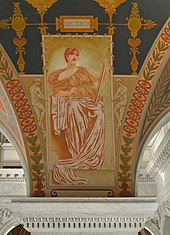
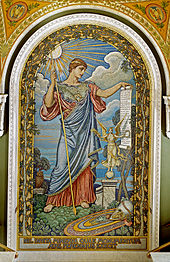
When Putnam retired in 1939, President Franklin D. Roosevelt appointed Archibald MacLeish as his successor. Occupying the post from 1939 to 1944 during the height of World War II, MacLeish became the most visible Librarian of Congress in the Library's history. MacLeish encouraged librarians to oppose totalitarianism on behalf of democracy; dedicated the South Reading Room of the Adams Building to Thomas Jefferson, commissioning artist Ezra Winter to paint four themed murals for the room; and established a "democracy alcove" in the Main Reading Room of the Jefferson Building for important documents such as the Declaration, Constitution and The Federalist Papers. The Library of Congress even assisted during the war effort, ranging from the storage of the Declaration of Independence and the United States Constitution in Fort Knox for safekeeping to researching weather data on the Himalayas for Air Force pilots. MacLeish resigned in 1944 to become Assistant Secretary of State, and President Harry Truman appointed Luther H. Evans as Librarian of Congress. Evans, who served until 1953, expanded the Library's acquisitions, cataloging and bibliographic services as much as the fiscal-minded Congress would allow, but his primary achievement was the creation of Library of Congress Missions around the world. Missions played a variety of roles in the postwar world: the mission in San Francisco assisted participants in the meeting that established the United Nations, the mission in Europe acquired European publications for the Library of Congress and other American libraries, and the mission in Japan aided in the creation of the National Diet Library.[7] Evans' successor L. Quincy Mumford took over in 1953. Mumford's tenure, lasting until 1974, saw the initiation of the construction of the James Madison Memorial Building, the third Library of Congress building. Mumford directed the Library during a period of increased educational spending, the windfall of which allowed the Library to devote energies towards establishing new acquisition centers abroad, including in Cairo and New Delhi. In 1967, the Library began experimenting with book preservation techniques through a Preservation Office, which grew to become the largest library research and conservation effort in the United States. Mumford's administration also saw the last major public debate about the Library of Congress' role as both a legislative library and a national library. A 1962 memorandum by Douglas Bryant of the Harvard University Library, compiled at the request of Joint Library Committee chairman Claiborne Pell, proposed a number of institutional reforms, including expansion of national activities and services and various organizational changes, all of which would shift the Library more towards its national role over its legislative role. Bryant even suggested possibly changing the name of the Library of Congress, which was rebuked by Mumford as "unspeakable violence to tradition". Debate continued within the library community until the Legislative Reorganization Act of 1970 shifted the Library back towards its legislative roles, placing greater focus on research for Congress and congressional committees and renaming the Legislative Reference Service to the Congressional Research Service.[7]
After Mumford retired in 1974, Gerald Ford appointed Daniel J. Boorstin as Librarian. Boorstin's first challenge was the move to the new Madison Building, which took place between 1980 and 1982. The move released pressures on staff and shelf space, allowing Boorstin to focus on other areas of Library administration such as acquisitions and collections. Taking advantage of steady budgetary growth, from $116 million in 1975 to over $250 million by 1987, Boorstin actively participated in enhancing ties with scholars, authors, publishers, cultural leaders, and the business community. His active and prolific role changed the post of Librarian of Congress so that by the time he retired in 1987, The New York Times called it "perhaps the leading intellectual public position in the nation".
President Ronald Reagan nominated James H. Billington as the 13th Librarian of Congress in 1987, and the U.S. Senate unanimously confirmed the appointment.[28] Under Billington's leadership, the Library doubled the size of its analog collections from 85.5 million items in 1987 to more than 160 million items in 2014. At the same time, it established new programs and employed new technologies to, "get the champagne out of the bottle." These included:
- American Memory created in 1990, which became The National Digital Library in 1994, providing free access online to digitized American history and culture resources with curatorial explanations for K-12 education.[29]
- thomas.gov website launched in 1994 to provide free public access to U.S. federal legislative information with ongoing updates; and congress.gov website to provide a state-of-the-art framework for both Congress and the public in 2012;[30]
- The National Book Festival, founded in 2000 with Laura Bush, has brought over 1000 authors and a million guests to the National Mall and the Washington Convention Center to celebrate reading. With a major gift from David Rubenstein in 2013, the Library also established the Library of Congress Literacy Awards to recognize and support achievements in improving literacy in the U.S. and abroad;[31]
- The Kluge Center, started with a grant of $60 million from John W. Kluge in 2000 to bring scholars and researchers from around the world to use Library resources and to interact with policymakers and the public. It hosts public lectures and scholarly events, provides endowed Kluge fellowships, and awards The Kluge Prize for the Study of Humanity (now worth $1.5 million), the first Nobel-level international prize for lifetime achievement in the humanities and social sciences (subjects not included in the Nobel awards);[32]
- Open World Leadership Center, established in 2000, administered 23,000 professional exchanges for emerging post-Soviet leaders in Russia, Ukraine and the other successor states of the former USSR by 2015. Open World began as a Library of Congress project, and later became an independent agency in the legislative branch.[33]
- The Veterans History Project, congressionally mandated in 2000 to collect, preserve, and make accessible the personal accounts of American war veterans from WWI to the present day;[34]
- The National Audio-Visual Conservation Center, which opened in 2007 at a 45-acre site in Culpeper, Virginia with the largest private gift ever made to the Library (more than $150 million by the Packard Humanities Institute) and $82.1 million additional support from Congress. In 1988, The Library also established the National Film Preservation Board, a congressionally mandated National Film Preservation Board to select American films annually for preservation and inclusion in the new National Registry. The Librarian named 650 films to the Registry by 2015;[35]
- The Gershwin Prize for Popular Song,[36] launched in 2007 to honor the work of an artist whose career reflects lifetime achievement in song composition. Winners have included Paul Simon, Stevie Wonder, Paul McCartney, Burt Bacharach and Hal David, Carole King, Billy Joel, and just-named Willie Nelson for November 2015. The Library also launched the Living Legend Awards in 2000 to honor artists, activists, filmmakers, and others who have contributed to America's diverse cultural, scientific, and social heritage;
- The Fiction Prize (now the Library of Congress Prize for American Fiction) started in 2008 to recognize distinguished lifetime achievement in the writing of fiction.[37]
- The World Digital Library, established in association with UNESCO and 181 partners in 81 countries in 2009, to make online copies of professionally curated primary materials of the world's varied cultures freely available in multiple languages.[38][38]
- National Jukebox launched in 2011 to provide streaming free online access to more than 10,000 out-of-print music and spoken word recordings.[39]
- BARD in 2013, digital talking books mobile app for Braille and Audio Reading Downloads in partnership with the Library's National Library Service for the blind and physically handicapped, that enables free downloads of audio and Braille books to mobile devices via the Apple App Store.[40]
During Billington's tenure as the 13th Librarian of Congress, the Library acquired Lafayette's previously inaccessible papers in 1996 from a castle at La Grange, France; and the only copy of the 1507 Waldseemüller world map ("America's birth certificate") in 2003 for permanent display in the Library's Thomas Jefferson Building. Using privately raised funds, the Library of Congress reconstructed Thomas Jefferson's original library, which was placed on permanent display in the Jefferson building in 2008.[41] Billington also enlarged and technologically enhanced public spaces of the Jefferson Building into a national exhibition venue, and hosted over 100 exhibitions.[42] These included exhibits on the Vatican Library and the Bibliothèque Nationale de France, several on the Civil War and Lincoln, on African-American culture, on Religion and the founding of the American Republic, the Early Americas (the Kislak Collection became a permanent display), on the global celebration commemorating the 800th anniversary of Magna Carta, and on early American printing featuring the Rubenstein Bay Psalm Book. Onsite access to the Library of Congress was also increased when Billington advocated successfully for an underground connection between the U.S. Capitol Visitors Center and the Library in 2008 to increase congressional usage and public tours of the Library's Thomas Jefferson Building.[28]
Under Billington, the Library launched a mass deacidification program in 2001, which has extended the lifespan of almost 4 million volumes and 12 million manuscript sheets; and new collection storage modules at Fort Meade, the first opening in 2002, to preserve and make accessible more than 4 million items from the Library's analog collections. Billington established the Library Collections Security Oversight Committee in 1992 to improve protection of collections, and also the Library of Congress Congressional Caucus in 2008 to draw attention to the Library's curators and collections. He created the Library's first Young Readers Center in the Jefferson Building in 2009, and the first large-scale summer intern (Junior Fellows) program for university students in 1991.[43] Under Billington, the Library also sponsored the Gateway to Knowledge in 2010-2011, a mobile exhibition to 90 sites covering all states east of the Mississippi in a specially designed 18-wheel truck, increasing public access to Library collections off-site, particularly for rural populations.[44]
Billington raised more than half a billion dollars of private support to supplement Congressional appropriations for Library collections, programs, and digital outreach. These private funds helped the Library to continue its growth and outreach in the face of a 30% decrease in staffing caused mainly by legislative appropriations cutbacks. He created the Library's first development office for private fundraising in 1987, and, in 1990, established the James Madison Council, the Library's first national private sector donor-support group. In 1987, Billington also asked the GAO to conduct the first Library-wide audit, and he created the first Office of the Inspector General at the Library to provide regular independent review of library operations. This precedent led to regular annual financial audits, leading to unmodified ("clean") opinions from 1995 onwards.[28]
In April 2010, it announced plans to archive all public communication on Twitter, including all communication since Twitter's launch in March 2006.[45] As of 2015[update], the Twitter archive remains unfinished.[46]
Before retiring in 2015, after 28 years of service, Billington had come "under pressure" as Librarian of Congress.[47] This followed a Government Accountability Office report which revealed a "work environment lacking central oversight" and faulted Billington for "ignoring repeated calls to hire a chief information officer, as required by law."[48]
When Billington announced his plans to retire in 2015, commentator George Weigel described the Library of Congress as "one of the last refuges in Washington of serious bipartisanship and calm, considered conversation," and "one of the world's greatest cultural centers."[49]
Carla Hayden was sworn in as the 14th Librarian of Congress on September 14, 2016, becoming both the first woman and the first African-American to hold the position.[50][51]
In 2017, the library announced the Librarian-in-Residence program which aims to support the future generation of librarians by giving them opportunity to gain work experience in five different areas of librarianship including: Acquisitions/Collection Development, Cataloging/Metadata, and Collection Preservation.[52]
Holdings[edit]

The collections of the Library of Congress include more than 32 million cataloged books and other print materials in 470 languages; more than 61 million manuscripts; the largest rare book collection[53] in North America, including the rough draft of the Declaration of Independence, a Gutenberg Bible (originating from the St. Blaise Abbey, Black Forest) (one of only three perfect vellum copies known to exist);[54][55][56] over 1 million U.S. government publications; 1 million issues of world newspapers spanning the past three centuries; 33,000 bound newspaper volumes; 500,000 microfilm reels; over 6,000 titles in all, totaling more than 120,000 issues comic book[57] titles; films; 5.3 million maps; 6 million works of sheet music; 3 million sound recordings; more than 14.7 million prints and photographic images including fine and popular art pieces and architectural drawings;[58] the Betts Stradivarius; and the Cassavetti Stradivarius.
The Library developed a system of book classification called Library of Congress Classification (LCC), which is used by most US research and university libraries.
The Library serves as a legal repository for copyright protection and copyright registration, and as the base for the United States Copyright Office. Regardless of whether they register their copyright, all publishers are required to submit two complete copies of their published works to the Library—this requirement is known as mandatory deposit.[59] Nearly 15,000 new items published in the U.S. arrive every business day at the Library. Contrary to popular belief, however, the Library does not retain all of these works in its permanent collection, although it does add an average of 12,000 items per day.[1] Rejected items are used in trades with other libraries around the world, distributed to federal agencies, or donated to schools, communities, and other organizations within the United States.[1] As is true of many similar libraries, the Library of Congress retains copies of every publication in the English language that is deemed significant.
The Library of Congress states that its collection fills about 838 miles (1,349 km) of bookshelves,[4] while the British Library reports about 388 miles (624 km) of shelves.[60] The Library of Congress holds more than 167 million items with more than 39 million books and other print materials,[4] against approximately 150 million items with 25 million books for the British Library.[60] A 2000 study by information scientists Peter Lyman and Hal Varian suggested that the amount of uncompressed textual data represented by the 26 million books then in the collection was 10 terabytes.[61]
The Library also administers the National Library Service for the Blind and Physically Handicapped, an audio book and braille library program provided to more than 766,000 Americans.
Digitization[edit]
The Library's first digitization project was called "American Memory." Launched in 1990, it initially planned to choose 160 million objects from its collection to make digitally available on laserdiscs and CDs that would be distributed to schools and libraries. After realizing that this plan would be too expensive and inefficient, and with the rise of the Internet, the Library decided to instead make digitized material available over the Internet. This project was made official in the National Digital Library Program (NDLP), created in October 1994. By 1999, the NDLP had succeeded in digitizing over 5 million objects and had a budget of $12 million. The Library has kept the "American Memory" name for its public domain website, which today contains 15 million digital objects, comprising over 7 petabytes.[62]
American Memory is a source for public domain image resources, as well as audio, video, and archived Web content. Nearly all of the lists of holdings, the catalogs of the library, can be consulted directly on its web site. Librarians all over the world consult these catalogs, through the Web or through other media better suited to their needs, when they need to catalog for their collection a book published in the United States. They use the Library of Congress Control Number to make sure of the exact identity of the book. Digital images are also available at Snapshots of the Past, which provides archival prints.[63]
The Library has a budget of between $6–8 million each year for digitization, meaning that not all works can be digitized. It makes determinations about what objects to prioritize based on what is especially important to Congress or potentially interesting for the public. The 15 million digitized items represent less than 10% of the Library's total 160-million item collection.
The Library has chosen not to participate in other digital library projects such as Google Books and the Digital Public Library of America, although it has supported the Internet Archive project.[62]
The Library of Congress also provides an online archive of the proceedings of the U.S. Congress at THOMAS, including bill text, Congressional Record text, bill summary and status, the Congressional Record Index, and the United States Constitution.
Buildings of the Library[edit]

The Library of Congress is physically housed in three buildings on Capitol Hill and a conservation center in rural Virginia. The Library's Capitol Hill buildings are all connected by underground passageways, so that a library user need pass through security only once in a single visit. The library also has off-site storage facilities for less commonly requested materials.
Thomas Jefferson Building[edit]
The Thomas Jefferson Building is located between Independence Avenue and East Capitol Street on First Street SE. It first opened in 1897 as the main building of the Library and is the oldest of the three buildings. Known originally as the Library of Congress Building or Main Building, it took its present name on June 13, 1980.[64]
John Adams Building[edit]
The John Adams Building is located between Independence Avenue and East Capitol Street on 2nd Street SE, the block adjacent to the Jefferson Building. The building was originally known as The Annex to the Main Building, which had run out of space. It opened its doors to the public January 3, 1939.[65]
James Madison Memorial Building[edit]
The James Madison Memorial Building is located between First and Second Streets on Independence Avenue SE. The building was constructed from 1971 to 1976, and serves as the official memorial to President James Madison.[66]
The Madison Building is also home to the Mary Pickford Theater, the "motion picture and television reading room" of the Library of Congress. The theater hosts regular free screenings of classic and contemporary movies and television shows.[67]
Packard Campus for Audio-Visual Conservation[edit]
The Packard Campus for Audio-Visual Conservation is the Library of Congress's newest building, opened in 2007 and located in Culpeper, Virginia.[68] It was constructed out of a former Federal Reserve storage center and Cold War bunker. The campus is designed to act as a single site to store all of the library's movie, television, and sound collections. It is named to honor David Woodley Packard, whose Packard Humanities Institute oversaw design and construction of the facility. The centerpiece of the complex is a reproduction Art Deco movie theater that presents free movie screenings to the public on a semi-weekly basis.[69]
Digital Millennium Copyright Act[edit]
The Library of Congress, through both the Librarian of Congress and the Register of Copyrights, is responsible for authorizing exceptions to Section 1201 of Title 17 of the United States Code as part of the Digital Millennium Copyright Act. This process is done every three years, with the Register receiving proposals from the public and acting as an advisor to the Librarian, who issues a ruling on what is exempt. After three years have passed, the ruling is no longer valid and a new ruling on exemptions must be made.[70][71]
Access[edit]
The library is open for academic research to anyone with a Reader Identification Card. One may not remove library items from the reading rooms or the library buildings. Most of the Library's general collection of books and journals is in the closed stacks of the Jefferson and Adams Buildings; specialized collections of books and other materials are in closed stacks in all three main Library buildings, or are stored off-site. Access to the closed stacks is not permitted under any circumstances, except to authorized Library staff, and occasionally, to dignitaries. Only the reading room reference collections are on open shelves.
Since 1902, American libraries have been able to request books and other items through interlibrary loan from the Library of Congress if these items are not readily available elsewhere. Through this system, the Library of Congress has served as a "library of last resort", according to former Librarian of Congress Herbert Putnam.[26] The Library of Congress lends books to other libraries with the stipulation that they be used only inside the borrowing library.[72]
Standards[edit]
In addition to its library services, the Library of Congress is also actively involved in various standard activities in areas related to bibliographical and search and retrieve standards. Areas of work include MARC standards, Metadata Encoding and Transmission Standard (METS), Metadata Object Description Schema (MODS), Z39.50 and Search/Retrieve Web Service (SRW), and Search/Retrieve via URL (SRU).[73]
The Law Library of Congress seeks to further legal scholarship by providing opportunities for scholars and practitioners to conduct significant legal research. Individuals are invited to apply for projects which would further the multi-faceted mission of the Law Library in serving the U.S. Congress, other governmental agencies, and the public.[74]
Annual events[edit]
- Fellows in American Letters of the Library of Congress
- Gershwin Prize for Popular Song
- Library of Congress Prize for American Fiction
- Founder's Day Celebration
- National Book Festival
Notable personnel[edit]
- Cecil Hobbs (1943–1971): American scholar of Southeast Asian history, head of the Southern Asia Section of the Orientalia (now Asian) Division of the Library of Congress, a major contributor to scholarship on Asia and the development of South East Asian coverage in American library collections[75]
See also[edit]
- Documents Expediting Project
- Federal Research Division
- Feleky Collection
- Law Library of Congress
- Library of Congress Classification
- Library of Congress Country Studies
- Library of Congress Living Legend
- Library of Congress Subject Headings
- Minerva Initiative
- National Digital Library Program (NDLP)
- National Film Registry
- National Recording Registry
- United States Senate Library
References[edit]
- ^ a b c d e "Fascinating Facts". Library of Congress. Retrieved 2018-04-25.
- ^ a b "2017 Annual Report of the Librarian of Congress" (PDF). Library of Congress. Retrieved 2018-11-27.
- ^ "Library of Congress". Encyclopedia Britannica. Retrieved 3 September 2017.
- ^ a b c "Fascinating Facts - Statistics". The Library of Congress. Retrieved 16 February 2017.
- ^ a b Murray, Stuart. The Library: An Illustrated History (New York, Skyhouse Publishing, 2012): 155.
- ^ 2 Stat. 55
- ^ a b c d e f g h i j k l "Jefferson's Legacy: A Brief History of the Library of Congress". Library of Congress. March 6, 2006. Retrieved January 14, 2008.
- ^ 2 Stat. 128
- ^ a b Murray, Stuart P. (2009). The library: an illustrated history. New York, NY: Skyhorse Pub. p. 158. ISBN 9781602397064.
- ^ Murray, Stuart (2009). The Library An Illustrated History. Chicago, Illinois: Skyhorse Publishing. p. 159.
- ^ Murray, Stuart (2009). The library : an illustrated history. New York, NY: Skyhorse Pub. ISBN 978-1-60239-706-4.
- ^ "Thomas Jefferson's personal library, at LibraryThing, based on scholarship". LibraryThing. Retrieved 2012-11-04.
- ^ LibraryThing profile page for Thomas Jefferson's library, summarizing contents and indicating sources
- ^ a b Murray, Stuart P. (2009). The library : an illustrated history. Chicago: Skyhorse Pub. p. 162. ISBN 9781602397064.
- ^ Fineberg, Gail (June 2007). "Thomas Jefferson's Library". The Gazette. Library of Congress. 67 (6). Retrieved 2015-01-04.
- ^ History, Art & Archives, U.S. House of Representatives. "An 1851 Library of Congress Fire". United States House of Representatives. Retrieved 30 April 2018.CS1 maint: Multiple names: authors list (link)
- ^ a b Cole, J.Y. (1993). Jefferson's Legacy: a brief history of the Library of Congress. Washington, D.C.: Library of Congress. p. 14.
- ^ Cole, J.Y. (2005). "The Library of Congress Becomes a World Leader, 1815-2005". Libraries & Culture. 40 (3): 386.
- ^ Interior Library. "History of the Interior Library". U.S. Department for the Interior. Retrieved 30 April 2018.
- ^ Smithsonian Institution (1904). An Account Of The Smithsonian: Its Origin, History, Objects and Achievements. Washington, D.C. p. 12.
|access-date=requires|url=(help) - ^ Mearns, D.C. (1946). The Story Up to Now: The Library of Congress, 1800–1946. Washington, D.C.: Government Printing Office. p. 100.
|access-date=requires|url=(help) - ^ Library of Congress. "Annual Report of the Librarian of Congress 1866" (PDF). U.S. Copyright Office. Retrieved 30 April 2018.
- ^ Gwinn, Nancy. "History". Smithsonian Libraries. Retrieved 30 April 2018.
- ^ a b c d Library of Congress. "John G Stephenson". John G Stephenson - Previous Librarians of Congress. Retrieved 30 April 2018.
- ^ These included future Librarian of Congress Herbert Putnam and Melvil Dewey of the New York State Library.
- ^ a b "Interlibrary Loan (Collections Access, Management and Loan Division, Library of Congress)". Library of Congress website. October 25, 2007. Retrieved December 4, 2007.
- ^ Snapp, Elizabeth (April 1975). "The Acquisition of the Vollbehr Collection of Incunabula for the Library of Congress". The Journal of Library History. University of Texas Press. 10 (2): 152–161. JSTOR 25540624. (restricted access)
- ^ a b c "Key Milestones of James H. Billington's Tenure | News Releases - Library of Congress". Loc.gov. Retrieved 2015-09-22.
- ^ "American Memory from the Library of Congress - Home Page". Memory.loc.gov. Retrieved 2015-09-22.
- ^ "Congress.gov | Library of Congress". www.congress.gov. Retrieved 2015-09-22.
- ^ "2015 Book Festival | National Book Festival - Library of Congress". Loc.gov. Retrieved 2015-09-22.
- ^ "The John W. Kluge Center - Library of Congress". Loc.gov. Retrieved 2015-09-22.
- ^ "Founding Chairman | OpenWorld". www.openworld.gov. Archived from the original on September 5, 2015. Retrieved September 22, 2015.
- ^ "Veterans History Project (Library of Congress)". Loc.gov. Retrieved 2015-09-22.
- ^ "Inside the Nuclear Bunker Where America Preserves Its Movie History". Retrieved 2015-09-22.
- ^ "Gershwin Prize". Retrieved 2015-09-22.
- ^ "Fiction Prize". Retrieved 2015-09-22.
- ^ a b "Background - World Digital Library". www.wdl.org. Retrieved 2015-09-22.
- ^ "National Jukebox LOC.gov". Loc.gov. Retrieved 2015-09-22.
- ^ "NLS Home". Loc.gov. Retrieved 2015-09-22.
- ^ "Thomas Jefferson's Library | Exhibitions - Library of Congress". loc.gov. Retrieved 2015-09-22.
- ^ "All Exhibitions - Exhibitions (Library of Congress)". Loc.gov. Retrieved 2015-09-22.
- ^ "2015 Junior Fellows Summer Intern Program Home (Library of Congress)". Loc.gov. Retrieved 2015-09-22.
- ^ "Gateway to Knowledge - Educational Resources - Library of Congress". Loc.gov. Retrieved 2015-09-22.
- ^ Grier, Peter (16 April 2010). "Twitter hits Library of Congress: Would Founding Fathers tweet?". Christian Science Monitor. Retrieved 2015-01-04.
- ^ Zimmer, Michael. "The Twitter Archive at the Library of Congress: Challenges for information practice and information policy". First Monday.
- ^ "Librarian of Congress gets a Due Date" by Maria Recio, McClatchy DC, Oct. 30. 2015
- ^ "America's 'national library' is lacking in leadership, yet another report finds" by Peggy McGlone, The Washington Post, March 31, 2015.
- ^ "America's Next 'Minister of Culture': Don't Politicize the Appointment". Retrieved 2015-09-22.
- ^ McGlone, Peggy; McGlone, Peggy (July 13, 2016). "Carla Hayden confirmed as 14th librarian of Congress". Washingtonpost.com. Retrieved May 5, 2017.
- ^ "Carla Hayden to be sworn in on September 14 - American Libraries Magazine". Americanlibrariesmagazine.org. Archived from the original on May 10, 2017. Retrieved May 5, 2017.
- ^ "Librarians-in-Residence -". The Library of Congress. Retrieved 2017-11-07.
- ^ "Rare Book and Special Collections Reading Room (Library of Congress)". Loc.gov. Retrieved 2017-05-05.
- ^ "Archived copy". Archived from the original on July 6, 2008. Retrieved 2008-04-01.CS1 maint: Archived copy as title (link)
- ^ "Octavo Editions: Gutenberg Bible". octavo.com. Archived from the original on 2004-11-27.
- ^ "Europe (Library of Congress Rare Books and Special Collections: An Illustrated Guide)". Loc.gov. Retrieved 2017-05-05.
- ^ "Comic Book Collection". The Library of Congress. April 7, 2006. Retrieved August 8, 2006.
- ^ Annual Report of the Librarian of Congress (PDF), Library of Congress, 2009
- ^ "Mandatory Deposit". Copyright.gov. Retrieved August 8, 2006.
- ^ a b "Facts and figures". British Library. Archived from the original on February 7, 2010. Retrieved June 30, 2011.
- ^ Lyman, Peter; Varian, Hal R. (18 October 2000). "How Much Information?" (PDF). Retrieved 2013-10-14.
- ^ a b Chayka, Kyle (2016-07-14). "The Library of Last Resort". n+1 Magazine. Retrieved 2016-07-19.
- ^ "About Us". Snapshots of the Past. Retrieved 2016-04-26.
- ^ Cole, John (2008). "The Thomas Jefferson Building". On These Walls: Inscriptions and Quotations in the Buildings of the Library of Congress. Scala Arts Publishers Inc. ISBN 978-1857595451. Retrieved 2018-04-23.
- ^ Cole, John (2008). "The John Adams Building". On These Walls: Inscriptions and Quotations in the Buildings of the Library of Congress. Scala Arts Publishers Inc. ISBN 978-1857595451. Retrieved 2018-04-23.
- ^ Cole, John (2008). "The James Madison Memorial Building". On These Walls: Inscriptions and Quotations in the Buildings of the Library of Congress. Scala Arts Publishers Inc. ISBN 978-1857595451. Retrieved 2018-04-23.
- ^ "Mary Pickford Theater Film Schedule". Moving Image Research Center. Library of Congress. Retrieved 2018-04-23.
- ^ "The Packard Campus - A/V Conservation (Library of Congress)". Loc.gov. Retrieved 2017-05-05.
- ^ "Library of Congress events listing". Loc.gov. Retrieved 2012-11-04.
- ^ "Section 1201: Exemptions to Prohibition Against Circumvention of Technological Measures Protecting Copyrighted Works". United States Copyright Office. 2013. Retrieved July 26, 2014.
- ^ "Statement Regarding White House Response to 1201 Rulemaking | News Releases - Library of Congress". Library of Congress. 2013. Retrieved July 26, 2014.
- ^ "Subpage Title (Interlibrary Loan, Library of Congress)". Loc.gov. 2010-07-14. Retrieved 2012-11-04.
- ^ "Standards at the Library of Congress". Loc.gov. Retrieved 2017-05-05.
- ^ "Research & Educational Opportunities - Law Library of Congress". Loc.gov. Retrieved May 5, 2017.
- ^ Tsuneishi, Warren (May 1992). "Obituary: Cecil Hobbs (1907-1991)". Journal of Asian Studies. 51 (2): 472–473. doi:10.1017/s0021911800041607.
- Mearns, David Chambers. The Story Up to Now: The Library Of Congress, 1800–1946 (1947), detailed narrative
Architecture[edit]
- Cole, John Y. and Henry Hope Reed. The Library of Congress: The Art and Architecture of the Thomas Jefferson Building (1998) excerpt and text search
- Small, Herbert, and Henry Hope Reed. The Library of Congress: Its Architecture and Decoration (1983)
Further reading[edit]
- Aikin, Jane (2010). "Histories of the Library of Congress". Libraries & the Cultural Record. 45 (1): 5–24. doi:10.1353/lac.0.0113.
- Anderson, Gillian B. (1989), "Putting the Experience of the World at the Nation's Command: Music at the Library of Congress, 1800-1917", Journal of the American Musicological Society, 42 (1): 108–49, doi:10.2307/831419
- Bisbort, Alan, and Linda Barrett Osborne. The Nation's Library: The Library of Congress, Washington, D. C. (Library of Congress, 2000)
- Cole, John Young. Jefferson's legacy: a brief history of the Library of Congress (Library of Congress, 1993)
- Cole, John Young. "The library of congress becomes a world library, 1815-2005." Libraries & culture (2005) 40#3: 385-398. in Project MUSE
- Cope, R. L. "Management Review of the Library of Congress: The 1996 Booz Allen & Hamilton Report," Australian Academic & Research Libraries (1997) 28#1 online
- Ostrowski, Carl. Books, Maps, and Politics: A Cultural History of the Library of Congress, 1783-1861 (2004) online
- Rosenberg, Jane Aiken. The Nation's Great Library: Herbert Putnam and the Library of Congress, 1899–1939 (University of Illinois Press, 1993)
- Shevlin, Eleanor F.; Lindquist, Eric N. (2010). "The Center for the Book and the History of the Book". Libraries & the Cultural Record. 45 (1): 56–69. doi:10.1353/lac.0.0112.
- Tabb, Winston; et al. (2003). "Library of Congress". Encyclopedia of Library and Information Science. 3: 1593–1612.
External links[edit]
| Wikimedia Commons has media related to Library of Congress. |
| Wikisource has the text of a 1905 New International Encyclopedia article about Library of Congress. |
- The Library of Congress website
- YouTube channel
- Search the Library of Congress catalog
- Congress.gov, legislative information
- Library Of Congress Meeting Notices and Rule Changes from The Federal Register RSS Feed
- Library of Congress photos on Flickr
- Outdoor sculpture at the Library of Congress
- Works by Library of Congress at Project Gutenberg
- Works by or about Library of Congress at Internet Archive
- Library of Congress at FamilySearch Research Wiki for genealogists
 . Encyclopedia Americana. 1920.
. Encyclopedia Americana. 1920.- C-SPAN's Library of Congress documentary and resources
- The Library of Congress National Library Service (NLS)
- Library of Congress
- 1800 establishments in Washington, D.C.
- Agencies of the United States Congress
- Archives in the United States
- Capitol Hill
- Deposit libraries
- Film archives in the United States
- Government agencies established in 1800
- History museums in Washington, D.C.
- Legislative libraries
- Libraries established in 1800
- Libraries in Washington, D.C.
- National libraries in the United States
- Photo archives
- Research libraries
- World Digital Library partners

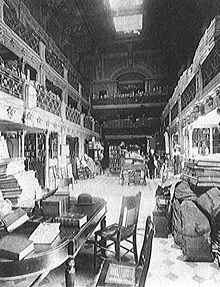
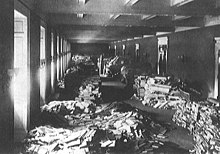
.jpg/220px-The_Library_of_Congress%2C_Washington-LCCN2008678216_(cropped).jpg)
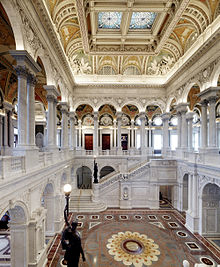
.jpg/220px-John_Adams_Building_(31274182293).jpg)
